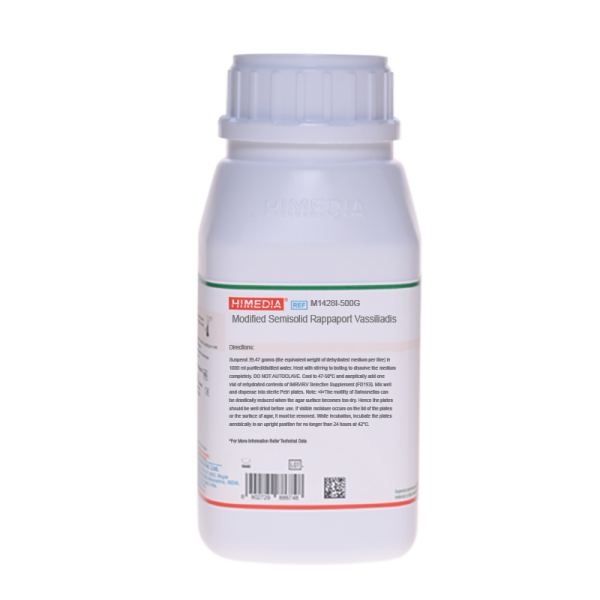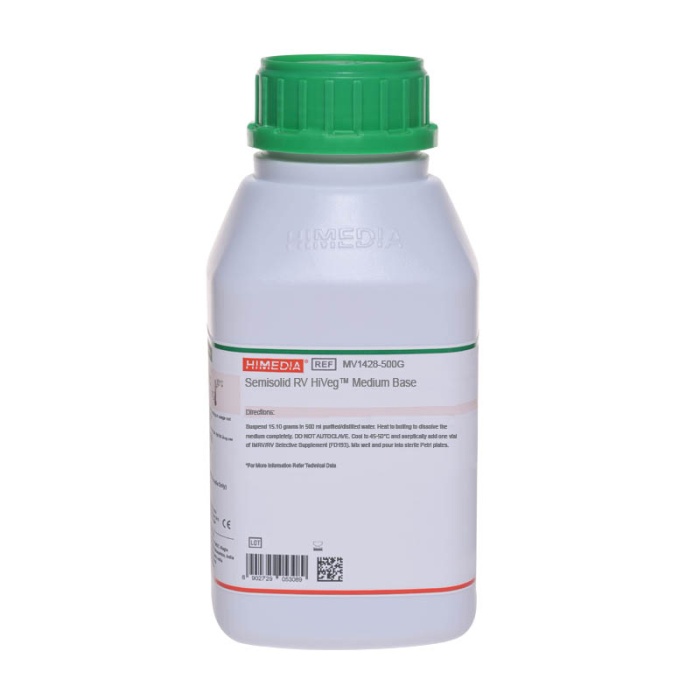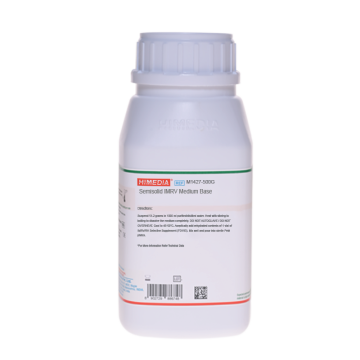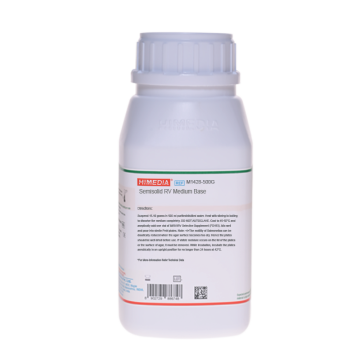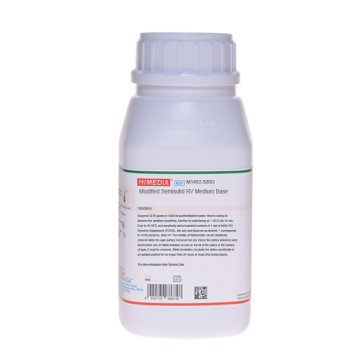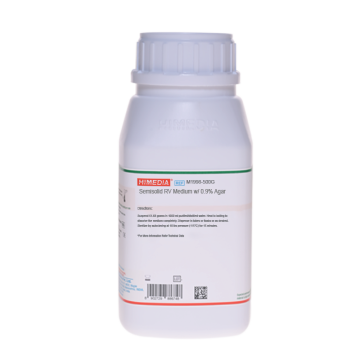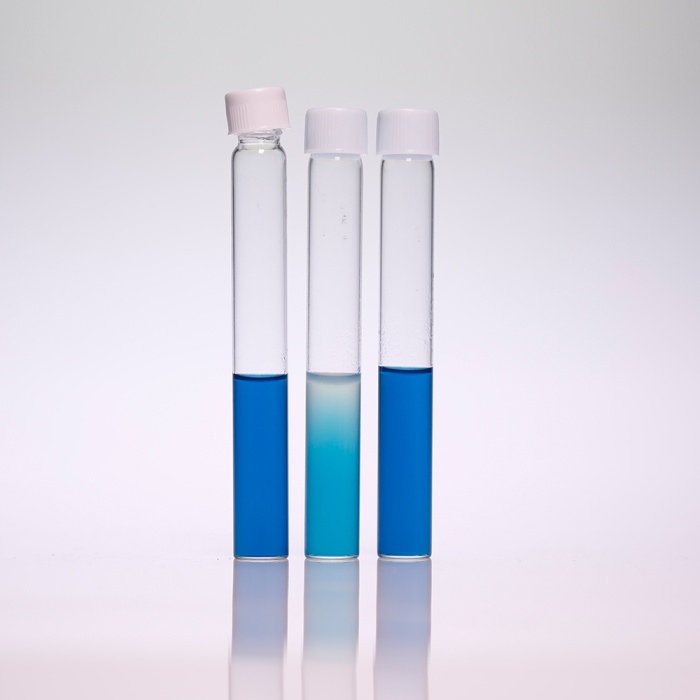 Your enquiry has been submitted
Your enquiry has been submitted
Modified Semi-solid Rappaport Vassiliadis Agar (MSRV)
Intended Use
Recommended for selective enrichment and isolation of Salmonella from food stuffs and environmental samples from the food production area. The composition and performance criteria of this medium are as per the specifications laid down in ISO 6579-1:2017 and ISO 11133:2014 (E) /Amd. :2020.
Composition**
ISO Specification - MSRV
| Ingredients | g / L |
|---|---|
| Enzymatic digest of animal and plant tissue | 4.600 |
| Acid hydrolysate of casein | 4.600 |
| Sodium chloride | 7.300 |
| Potassium dihydrogen phosphate (K2HPO4) | 1.500 |
| Magnesium chloride, hexahydrate (MgCl2 6H2O) | 40.00 |
| Malachite green oxalate | 0.040 |
| Agar | 2.700 |
Final pH (after sterilization) at 20-25°C 5.10-5.40
Modified Semisolid Rappaport Vassiliadis Medium Base (MSRV)
| Ingredients | g / L |
|---|---|
| Biopeptone # | 4.600 |
| Acicase ## | 4.600 |
| Sodium chloride | 7.300 |
| Potassium dihydrogen phosphate | 1.500 |
| Magnesium chloride, hexahydrate | 40.00 |
| Malachite green oxalate | 0.040 |
| Agar | 2.700 |
Final pH (after sterilization) at 20-25°C 5.10-5.40
Supplements to be added after autoclaving
| g / L | |
|---|---|
| Novobiocin | 0.010 |
| FD193 | 1 vial |
|---|---|
| Novobiocin | 0.010 g |
**Formula adjusted, standardized to suit performance parameters # Equivalent to Enzymatic digest of animal and plant tissue ## Equivalent to Acid hydrolysate of casein
Directions
Suspend 39.47 gram (the equivalent weight of dehydrated medium per litre) in 1000 ml purified/distilled water. Heat with stirring to boiling to dissolve the medium completely. DO NOT AUTOCLAVE. Cool to 47-50°C and aseptically add 1 vial of rehydrated content of IMRV/RV Selective Supplement (FD193). Mix well and dispense into sterile Petri plates.
Note: The motility of Salmonellas can be drastically reduced when the agar surface becomes too dry. Hence the plates should be well dried before use. If visible moisture occurs on the lid of the plates or the surface of agar, it must be removed. While incubation, incubate the plates aerobically in an upright position for no longer than 24 hours at 42°C.
Principle And Interpretation
Semisolid Rappaport Vassiliadis Medium Base is based on the formulation described by DeSmedt et al (1) for the detection of motile Salmonella species from food and environmental specimens. Modified Semisolid Rappaport Vassiliadis Medium Base is recommended by ISO 6579 (2) and ISO 11133 (3) for detection of Salmonella from foodstuffs and the area of food production and food handling. This medium detects more Salmonella positive samples than the routinely used enrichment procedures (2-4). Bio peptone and Acicase provides the nitrogenous and carbonaceous substances, long chain amino acids, vitamins and other essential growth nutrients. The motility of other microorganisms is largely inhibited by the selective agents (magnesium chloride, malachite green and novobiocin). Sodium chloride maintains osmotic balance. Phosphate buffers the medium. The working of medium is based on the ability of Salmonella species to migrate in the selective medium competing with the other motile organisms, thus producing opaque halos of growth. The motile bacteria will show a halo or zone of growth originating from inoculation spot.
Type of specimen
Food and animal feeding samples, environmental samples in the area of food production and food handling. Samples from primary production stage such as animal faeces, dust and swabs.
Specimen Collection and Handling:
Processesing: ISO 6579-1:2017 & ISO 11133:2014, Amd 2018 (2,3)
- Pre-enrichment: Samples (25 gram in 225 ml) are preenriched in Buffered Peptone Water (M14941) and incubated at 34°C to 38°C for 18 h ± 2 hours.
- Selective enrichment: 0.1 ml of pre- enriched sample is inoculated in 10 ml RVS Broth (M1448I) or MSRV Agar (M1428) and incubated at 41.5 ± 1°C for 24 ± 3 hours and 1 ml of culture is inoculated in MKTTn broth (M14961) and incubated at 37±1°C for 24 ± 3 hours.
- Isolation: The culture thus obtained is then plated on XLD Agar, Modified (M031I) and incubated at 37± 1°C for 24 ± 3 hours. Simultaneously plating on second isolation agar is carried out.
- Confirmation: Biochemical and serological tests are performed for confirmation.
Warning and Precautions :
Read the label before opening the container. Wear protective gloves/protective clothing/eye protection/ face protection. Follow good microbiological lab practices while handling specimens and culture. Standard precautions as per established guidelines should be followed while handling specimens. Safety guidelines may be referred in individual safety data sheets.
Limitations :
- The medium is intended for the detection of motile Salmonella and is not appropriate for the detection of non- motile Salmonella strains.
- Individual organisms differ in their growth requirement and may show variable growth patterns in the medium
- Each lot of the medium has been tested for the organisms specified on the COA. It is recommended to users to validate the medium for any specific microorganism other than mentioned in the COA based on the user's unique requirement.
- Further biochemical tests must be carried out for confirmation.
Performance and Evaluation
Performance of the medium is expected when used as per the direction on the label within the expiry period when stored at recommended temperature.
Quality Control
Appearance Light yellow to light blue homogeneous free flowing powder
Gelling Semisolid, comparable with 0.27% Agar gel.
Colour and Clarity of prepared medium Blue coloured clear to slightly opalescent semisolid gel forms in Petri plates.
Reaction Reaction of 3.95% w/v aqueous solution at 25°C. pH after sterilization : 5.10-5.40
pH 5.10-5.40
Cultural Response
M1428I: Cultural characteristics observed after an incubation at 41.5°C± 1°C for 24 hours with added IMRV/RV Selective Supplement (FD193) when one drop of culture is inoculated in the centre of the medium plate.(Motility is checked by inoculating a drop of culture in the centre of the medium plate).Additional incubation of 24±3 hours is recommended if negative results are obtained after 24 hours.
| Organism | Inoculum (CFU) | Motility |
|---|---|---|
| Productivity | ||
| Salmonella Enteritidis ATCC 13076 (00030*) | 103-104 | Positive Grey-white, turbid zone extending out from inoculated drop(s). Positive, After 24 h to 48h, the turbid zone(s)will be (almost) fully migrated over the plate.@ |
| Salmonella Typhimurium ATCC 14028 (00031*) | 103-104 | Positive Grey-white, turbid zone extending out from inoculated drop(s). Positive, After 24 h to 48h, the turbid zone(s) will be (almost) fully migrated over the plate.@ |
| Selectivity | ||
| Escherichia coli ATCC 25922 (00013*) | 104-106 | Possible growth at the place of the inoculated drop(s) without a turbid zone |
| Escherichia coli ATCC 8739 (00012*) | 104-106 | Possible growth at the place of the inoculated drop(s) without a turbid zone |
| Enterococcus faecalis ATCC 29212 (00087*) | 104-106 | No growth |
| Enterococcus faecalis ATCC 19433 (00009*) | 104-106 | No growth |
Key: (*) Corresponding WDCM numbers @ Possible extra: characteristic colonies after subculturing on XLD agar
Storage and Shelf Life
Store between 10-30°C in tightly closed container. Use freshly prepared medium. Use before expiry period on the label. On opening, product should be properly stored dry, after tightly capping the bottle in order to prevent lump formation due to the hygroscopic nature of the product. Improper storage of the product may lead to lump formation. Store in dry ventilated area protected from extremes of temperature and sources of ignition Seal the container tightly after use. Product performance is best if used within stated expiry period.
Disposal
User must ensure safe disposal by autoclaving and/or incineration of used or unusable preparations of this product. Follow established laboratory procedures in disposing of infectious materials and material that comes into contact with sample must be decontaminated and disposed of in accordance with current laboratory techniques (4,5).
Reference
- De Smedt J.M., Balderdijk R., Rappold H. and Lautenschlaeger D., 1986, J. Food Prot., 49:510.
- International Organization for Standardization 6579-1:2017(E), Microbiology of the food chain — Horizontal method for the detection, enumeration and serotyping of Salmonella.
- Microbiology of food,animal feeding stuffs and water- Preparation, production,storage and performance testing of culture media, EN ISO 11133:2014 (E) /Amd. :2020.
- Isenberg, H.D. Clinical Microbiology Procedures Handbook. 2nd Edition.
- Jorgensen, J.H., Pfaller, M.A., Carroll, K.C., Funke, G., Landry, M.L., Richter, S.S and Warnock., D.W.(2015) Manual of Clinical Microbiology, 11th Edition. Vol. 1.
| Product Name | Modified Semi-solid Rappaport Vassiliadis Agar (MSRV) |
|---|---|
| SKU | M1428I |
| Product Type | Regular |
| Physical Form | Powder |
| Origin | Animal |
| Packaging type | HDPE |
| References | 1. De Smedt J.M., Balderdijk R., Rappold H. and Lautenschlaeger D., 1986, J. Food Prot., 49:510.2.International Organization for Standardization 6579-1:2017(E), Microbiology of the food chain — Horizontal method for the detection, enumeration and serotyping of Salmonella |
| Customized Product Available | No |



